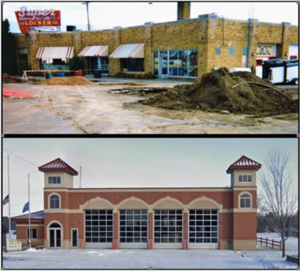The Wisconsin Department of Natural Resources (DNR) will host learning sessions for local governments on redevelopment of underused and abandoned properties, otherwise known as brownfields, on Nov. 12 in Whitewater, Nov. 15 in Dodgeville and Nov. 20 in Shawano. The sessions are free to attend and the same content will be covered in each location.
A brownfield is a property where real or perceived contamination complicates expansion, redevelopment or reuse. Brownfields may be found in many locations throughout the state and vary in size, age and past use.
The in-person sessions will share information about resources available to support local governments in redevelopment of properties into community assets. Participants will learn how to identify brownfield sites in their community and understand the liability considerations and due diligence recommended when acquiring brownfield properties. Highlights of the sessions include an overview of funding and other assistance available to support redevelopment efforts.
“I didn’t know what a brownfield was until the day before the event,” states Lisa Lien, clerk for the village of Clayton said after attending an event hosted by the DNR in Spooner in April 2024. “I learned a ton during the seminar and now have a great understanding of brownfield redevelopment.”
The learning sessions will also offer an opportunity for local governments to connect one-on-one with representatives from the DNR and Wisconsin Economic Development Corporation (WEDC) and ask questions about brownfield properties and redevelopment.
Session Information

Redevelopment from downtown brownfield into a fire station in the city of Amery
Nov. 12, 2024
The Innovation Center
1221 Innovation Dr.
Whitewater
Time: 10 a.m. – noon
Nov. 15, 2024
Community Room
Iowa County Health & Human Services Bldg
303 W Chapel St.
Dodgeville
Time: 11:15 a.m. – 1:15 p.m.
Nov. 20, 2024
Community Room, City Hall
127 S Sawyer St.
Shawano
Time: 10 a.m. – noon
Local government officials interested in learning more about brownfield redevelopment in Wisconsin are encouraged to attend. To register for one of the sessions, contact Thomas.Coogan@wisconsin.gov by Nov. 7, 2024.
More information about DNR’s brownfield cleanup programs and services is available on the DNR’s brownfields webpage. The page provides access to a webinar series titled “Brownfields Fundamentals” for on-demand information on brownfield redevelopment topics.
DNR staff around the state are available to meet with community leaders, bankers, developers and private individuals to discuss brownfield projects. Reach out to schedule a Green Team meeting.

